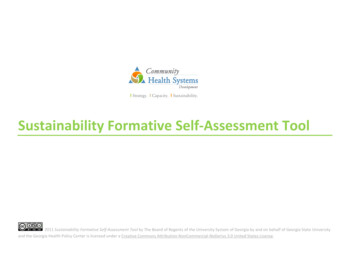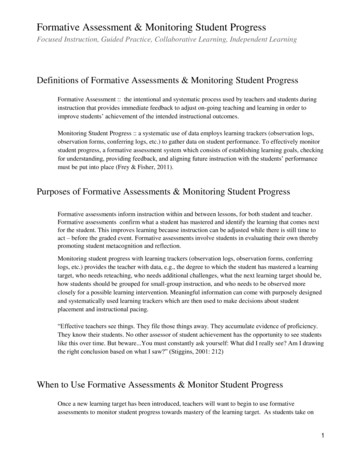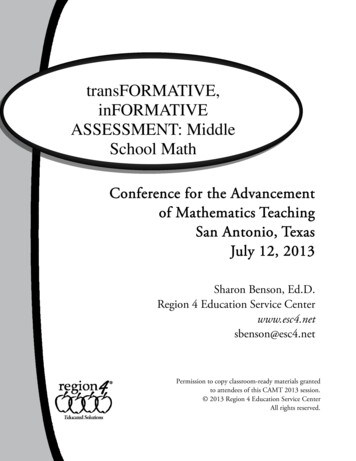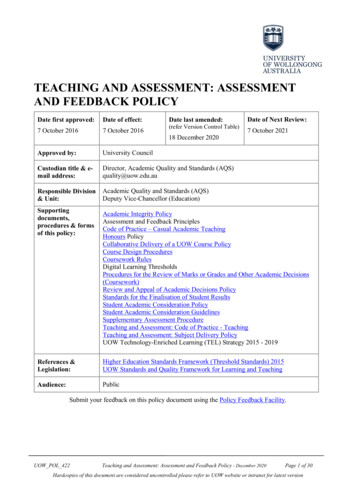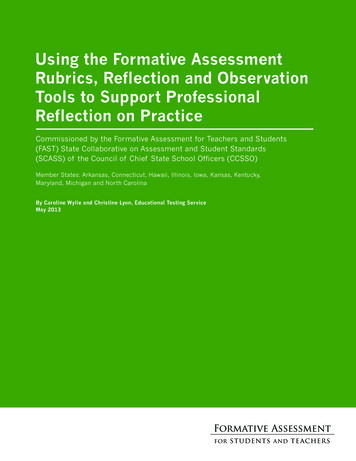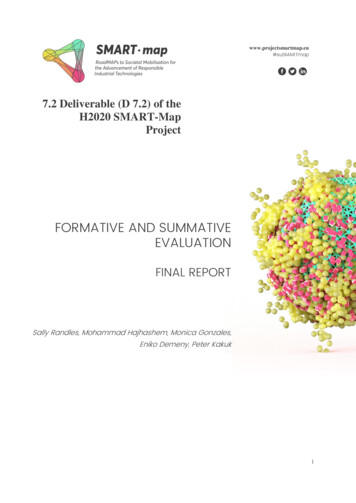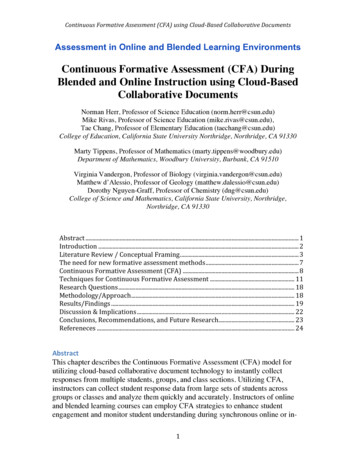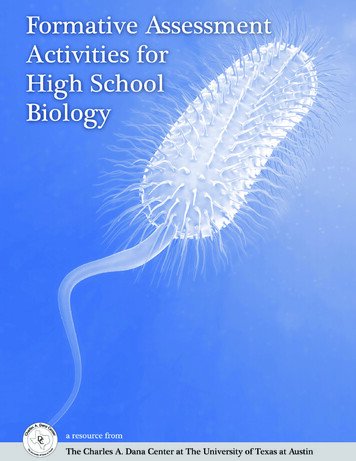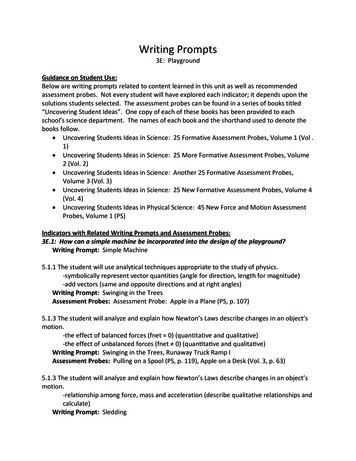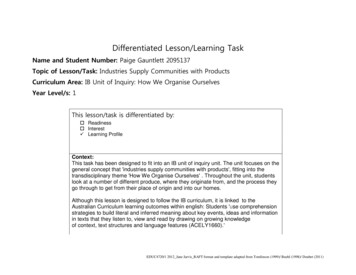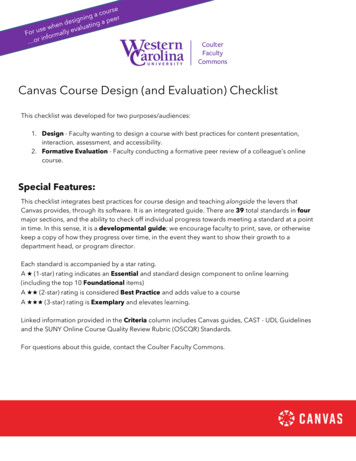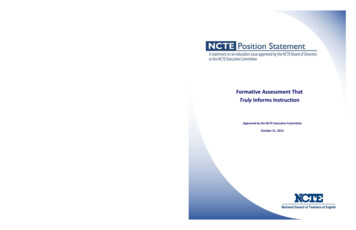
Transcription
NCTE Assessment Task ForceChair:Cathy Fleischer, Eastern Michigan University, YpsilantiMembers:Scott Filkins, Champaign School District, ILAntero Garcia, Colorado State University, Fort CollinsKathryn Mitchell Pierce, Wydown Middle School, Clayton, MOLisa Scherff, Estero High School, FLFranki Sibberson, Dublin City Schools, OHNCTE Staff Liaison, Millie DavisPermission is granted to reproduce in whole or in part the material in this publication, with proper credit to the National Council ofTeachers of English. Because of specific local problems, some schools may wish to modify the statements and arrange separately forprinting or duplication. In such cases, of course, it should be made clear that revised statements appear under the authorization andsponsorship of the local school or association, not NCTE.This position statement may be printed, copied, and disseminated without permission from NCTE.Formative Assessment ThatTruly Informs InstructionApproved by the NCTE Executive CommitteeOctober 21, 2013
Effective teachers are constantly engaged in the process of formative assessment: offering one more bit of explanation from thefront of the room when students’ heads tilt and brows furrow, asking a student to re-read a paragraph (this time aloud, maybe)when he shrugs at a question in a conference, handing a student her soon-to-be new favorite book based on the dozens ofconversations about the kinds of stories she likes and doesn’t over the course of the year. These acts of decision making, informedby student response to purposeful or intuitive prompts, are the threads out of which skill, knowledge, and understanding arewoven collaboratively by teachers and students.Formative assessment is the lived, dailyembodiment of a teacher’s desire torefine practice based on a keenerunderstanding of current levels ofstudent performance, undergirded bythe teacher’s knowledge of possiblepaths of student development withinthe discipline and of pedagogies thatsupport such development.Formative assessment can look more structured, too, with teachersbeginning a class period with a discussion of a short list of generalmisunderstandings garnered from a recent quiz, grouping students withvaried activities based on the writing they did the class period before,or pairing students to read each other’s drafts with a prepared list ofquestions and prompts. In whatever shape it takes, formativeassessment is the lived, daily embodiment of a teacher’s desire torefine practice based on a keener understanding of current levels ofstudent performance, undergirded by the teacher’s knowledge ofpossible paths of student development within the discipline and ofpedagogies that support such development. At its essence, trueformative assessment is assessment that is informing—to teachers,students, and families.Well over a decade into federal education policy that endows significant consequences to single tests of student achievement toolate in the academic year to lead to any action, teachers might be pleased that the term “formative assessment” is appearing inthe broader discourse among test makers and publishers of educational materials. Teachers are very aware that frequent, inprocess checks for understanding are what allow them to teach better and improve student achievement, an awareness that hasbeen supported by extensive research into formative assessment since the 1960s. However, applying the term “formativeassessment” to those commercial products or tools that are sought out, purchased, or imposed by those least involved in the dailywork of classroom learning raises serious concerns: Unless a formative assessment tool functions demonstrably as a lever formeaningful teacher and student decision making, it is being marketed under erroneous pretenses. While well-designed tools orassessment strategies are a key component to authentic formative assessment, if they are not what teachers consider the righttools for the immediate task at hand, they are frustrating and counterproductive.The sections that follow offer first a broad discussion of the many and varied purposes of assessment, followed by an explanationof what formative assessment is and is not, highlighting the central importance of teacher decision making in the process ofassessment that informs instruction and improves student learning. At the end, readers will find a checklist for decision makersconsidering the best ways to incorporate formative assessment into the learning cycle of students in their schools.Serafini, F. (2000/2001). Three paradigms of assessment: Measurement, procedure, and inquiry. The Reading Teacher, 54.4, 384–393.The author argues that as curriculum has developed from a series of facts to be memorized, to activities to be completed, to knowledge tobe constructed through inquiry, so has assessment shifted from an act of measurement to a process of teacher and student inquiry. Heenvisions teachers as active creators of knowledge about their students and offers practical suggestions for supporting teachers in thiswork, including providing time and support for shifting the purposes and audiences for assessment.Serafini, F. (2010). Classroom reading assessments: More efficient ways to view and evaluate your readers. Portsmouth, NH: Heinemann.Serafini describes assessments as “windows” through which teachers observe their students, acknowledging that there are many windowsto choose from and all of them are limited in terms of what they allow us to see and understand. The power of these assessment“windows,” in a context of inquiry, is that they help to make us better observers of students. The book is clearly organized with a wealth ofpractical examples and includes explanations of the research support for the practices he advocates. Chapter 2 provides an in-depth look atthe processes and lenses teachers use as they generate assessment information about their students. Throughout the book, Serafinihighlights the central role of the classroom teacher in the assessment process.ndShagoury, R., & Power, B. (2012). Living the questions: A guide for teacher-researchers (2 ed.). Portland, ME: Stenhouse.Learning to use observations and careful study of student artifacts of learning is critical to being able to use assessment to informinstruction. Shagoury and Power provide detailed examples of the ways teachers generate and collect information about their students.The focus is on learning to look closely at students engaged in the learning process and at the work they create, in order to build a morecomplex understanding of what students are learning and working at understanding. Although the primary purpose of the book is tosupport teacher-researchers, the stances and strategies are useful for teachers who do not see themselves as researchers, but who viewassessment through an inquiry stance.Stephens, D. (2013). Reading assessment: Artful teachers, successful students. Urbana, IL: NCTE.Edited by Diane Stephens, this book offers portraits of elementary classroom teachers and literacy coaches as they use a variety offormative assessments to improve reading practices of young students. As these literacy professionals show how and why they use multipleassessments, we watch them take control of their own classrooms as they use the results of those assessments to determine meaningfulinstruction for young readers. This book is part of NCTE’s Principles in Practice imprint, based in the IRA-NCTE Standards for the Assessmentof Reading and Writing.Tomlinson, C. (Dec. 2007/Jan. 2008). Learning to love assessment. Educational Leadership, 65.4, 8–13.In this brief and highly readable article, Tomlinson outlines the progression of her thinking about classroom assessment. In explaining eachnew critical insight, she helps teachers understand how reflecting on their practice can lead to more sophisticated understanding of theteacher-learning process and the central role of “informative” assessment in that process. Tomlinson stresses the value of adopting an“assessment as learning” stance—a stance that supports teacher learning as well as student learning.Tovani, C. (2011). So what do they really know? Assessment that informs teaching and learning. Stenhouse.Not All Formative Assessment Is Created EqualTeachers and schools assess students in a variety of ways for a variety of reasons—from the broad categories of sorting, ranking,and judging to the more nuanced purposes of determining specific levels of student understanding, restructuring curricula to meetstudent needs, and differentiating instruction among students. In the recent past, educators have made a strong distinctionbetween summative assessment (generally seen as a final evaluative judgment) and formative assessment (generally seen asongoing assessment to improve teaching and learning). However, in today’s assessment environment this distinction may be afalse one; in fact, many believe the difference between the two terms has more to do with how the data that is generated fromassessments is actually used (Gallagher). For example, formative assessments that are really mini-summative assessments,designed in large part to improve performance on summative assessments, are quite different from formative assessments that“occur at or near the point of instruction, allowing teachers and students to make the right decisions about teaching and learningat the right time for the right reasons” (Gallagher 82). Johnston (1997) offers a useful distinction between these two types ofassessment when he suggests that questions or assessments can be interpreted either as genuine requests for information or asassertions of control. Teacher-created classroom assessments designed to inform instruction are much more likely to function asreal requests for information that can change instruction and improve learning; "mini-summative" assessments, because of the2Tovani provides an in-depth look at the ways she assesses students in her classroom and what she has learned along the way about theassessment process. She divides assessment into two categories: formative assessment that is designed to help her shape and adjust herteaching and summative assessment that is to determine what students have learned and where students are "ranked" on a particular skill.The specific classroom examples and forms highlight the ways she gathers, organizes, reflects on, and uses this important data in order toplan for instruction.11
Frey, N., & Fisher, D. (2013). A formative assessment system for writing improvement. English Journal, 103.1, 66–71.The authors offer practical means for acting on information gathered about student writers by suggesting the use of error analysis sheetsto look for patterns on drafts-in-process to focus instruction for whole class needs, small group needs, and individual needs.Gallagher, C. W., & Turley, E. D. (2012). Our better judgment: Teacher leadership for writing assessment. Urbana, IL: NCTE.Gallagher and Turley focus on writing assessment at the secondary level, offering portraits of teachers who have created thoughtful andmeaningful assessments designed to help improve student writing. Through these portraits, they demonstrate that in order to stop beingtreated “as targets of assessment rather than agents of it,” teachers must build their own expertise in assessment. Throughout the book,they offer a number of concrete ideas of how teachers might take on this role. This book is part of NCTE’s Principles in Practice imprint,based in the IRA-NCTE Standards for the Assessment of Reading and Writing.Heritage, M. (2007). Formative assessment: What do teachers need to know and do? Phi Delta Kappan, 89(2). Retrieved fromhttp://www.pdkintl.org/kappan/k v89/k0710her.htm.In this article Heritage defines formative assessment as often implemented in the classroom as part of a learning cycle: on-the-fly,planned-for, and curriculum-embedded. She suggests that four core elements comprise formative assessment and that teachers need tohave a clear understanding of them. She also suggests that teachers need specific knowledge and skills in order to use formativeassessment successfully.Landrigan, C., & Mulligan, T. (2013). Assessment in perspective: Focusing on the readers behind the numbers. Portland, ME: Stenhouse.This book takes a close look at assessment that focuses on children. While acknowledging the amount of pressure current mandates areputting on teachers, Landrigan and Mulligan put things in perspective so that teachers can focus on the authentic, daily assessments thatimprove instruction. The authors argue that a single number does not tell the whole story of a child’s literacy and that empoweringstudents to take a role in their assessment is critical. This book shares strategies for using information to help teachers understand eachchild’s strengths and needs. The book acknowledges that the teacher decision making is what matters most in a classroom when it comesto assessment.Murphy, S., & Smith, M. A. (2013). Assessment challenges in the common core era. English Journal, 103.1, 104–110.Building on the work of Paul Black and Dylan Wiliam, the authors argue for the value of a portfolio-based assessment system in providingformative and summative assessment information about student writers/writing. They point to key features of portfolios as sites offormative assessment, namely their embedded nature in the teaching and learning context, their involvement of the student inmetacognitive reflection on both product and process, and the wealth of information they generate that can guide instructional decisionmaking.Overmeyer, M. (2009). What student writing teaches us: Formative assessment in the writing workshop. Portland, ME: Stenhouse.Overmeyer includes sections that clarify the distinction between formative and summative assessment, noting the central role of teacherobservation in the formative assessment process. Overmeyer highlights his belief that formative assessment involves teachersdeliberately developing and/or changing their teaching plans based on their observations of students and their writing. Chapter three isspecifically focused on the ways that teachers provide feedback to students and how this feedback functions as a type of formativeassessment.Pinchok, N., & Brandt, W. C. (2009). Connecting formative assessment research to practice: An introductory guide for educators.Washington, DC: Learning Point Associates.This Research to Practice Brief was published to increase the knowledge and “build the capacity” of local and state school staff andleaders to implement effective formative assessments. The authors define formative assessment, review commonly used school-basedassessments, and delineate the formative assessment process. The brief also provides suggestions for involving district- and state-levelleaders in formative assessment practices.10external imposition and distance from in-the-moment decision making, serve as a means of control (of teachers, students, andcurriculum). Thus, while many recently released commercial products advertised as formative assessment suggest that theirmain use is to prepare students for summative assessment, most educators recognize formative assessment as “a systematicprocess to continually gather evidence about student learning” (Heritage, 141). This kind of authentic formative assessment,teachers contend, is rooted in instructional activity and is connected directly to the teaching and learning occurring at thatmoment (Pinchot & Brandt).Over 30 years of research suggest formative assessment is a vital curricular component, proven to be highly effective inincreasing student learning (Black & Wiliam 1998). Cizek distilled this research, identifying 10 elements across the studies thatresearchers have noted as important features (Cizek 8).Formative assessment:1. Requires students to take responsibility for their own learning.2. Communicates clear, specific learning goals.3. Focuses on goals that represent valuable educational outcomes with applicability beyond the learning context.4. Identifies the student’s current knowledge/skills and the necessary steps for reaching the desired goals.5. Requires development of plans for attaining the desired goals.6. Encourages students to self-monitor progress toward the learning goals.7. Provides examples of learning goals including, when relevant, the specific grading criteria or rubrics that will be used toevaluate the student’s work.8. Provides frequent assessment, including peer and student self-assessment and assessment embedded within learningactivities.9. Includes feedback that is non-evaluative, specific, timely, and related to the learning goals, and that providesopportunities for the student to revise and improve work products and deepen understandings.10. Promotes metacognition and reflection by students on their work.Heritage further categorizes formative assessments into three types that all contribute to the learning cycle: “on-the-fly” (those that happen during a lesson), “planned-for-interaction” (those decided before instruction), and “curriculum-embedded” (embedded in the curriculum and used to gather data at significant points during the learningprocess).At the center of all this research is one underlying idea: Formativeassessment is a constantly occurring process, a verb, a series of events inaction, not a single tool or a static noun. In order for formative assessmentto have an impact on instruction and student learning, teachers must beinvolved every step of the way and have the flexibility to make decisionsthroughout the assessment process. Teachers are “the primary agents, notpassive consumers, of assessment information. It is their ongoing,formative assessments that primarily influence students’ learning” (JointTask Force on Assessment, Standard 2).At the center of all this research isone underlying idea: Formativeassessment is a constantlyoccurring process, a verb, a seriesof events in action, not a single toolor a static noun.Formative Assessment as StanceIn order for teachers to be successful assessors, they must develop an “assessment literacy” (Gallagher & Turley): a deepunderstanding of why they assess, when they assess, and how they assess in ways that positively impact student learning. Inaddition, successful teacher assessors view assessment through an inquiry lens, using varying assessments to learn from andwith their students in order to adjust classroom practices accordingly. Together these two qualities—a deep knowledge ofassessment and an inquiry approach to assessment—create a particular stance toward assessment.3
When teachers who hold this stance as knowledgeable inquirers are given the autonomy to make decisions about theassessment practices that will provide meaningful information in their own classrooms, formative assessment can indeed bepowerful and productive, especially those assessments that are planned, designed, implemented, and studied by the classroomteacher (Stephens & Story). The most meaningful of these assessments provide information the teacher can use to betterunderstand her students and to then support them in taking the next steps in their learning. The best formative assessments arenot focused exclusively on externally mandated learning outcomes but also on timely information that teachers can use todetermine a student’s current understanding and the areas that are nearly within the student’s reach (Vygotsky).As knowledgeable inquirers, teachers are able to choose among a variety of tools and strategies that best suit the context oftheir own classrooms. Analogous to the work of ethnographers or teacher researchers, teachers use meaningful formativeassessment to study students in action and the artifacts of their learning in order to better understand.Tools and Strategies of Formative AssessmentAs teachers conduct their assessment work from this stance of knowledgeable inquirers, they have many strategies and toolsfrom which to choose. Successful teacher assessors carefully select or create the right assessment at the right time in order toinform instruction and support the learner, thoughtfully administering the assessment with the least disruption to the ongoinglearning in the classroom (Serafini). These assessments might be grouped into four types—Observations, Conversations, StudentSelf-Evaluations, and Artifacts of Learning—briefly described below. Further examples of teacher-based formative assessmentscan be accessed from this document’s Annotated Bibliography and on NCTE’s website: http://www.ncte.org/assessment.Wiliam, D. (2010). An integrative summary of the research literature and implications for a new theory of formative assessment. In H.Andrade & G. Cizek (Eds.), Handbook of Formative Assessment (pp. 18–40). New York: Routledge.Wiliam’s essay offers meta-analyses of studies surrounding formative assessment as well as a meticulously researched discussion of variousdefinitions of formative assessment. He then suggests new definitions and directions for formative assessment that focus on “the extent towhich evidence of learner achievement is used to inform decisions about teaching and learning.” Useful essay for those seeking exposure toscholarly studies on formative assessment.Practical ApplicationsBoudett, K., City, E., & Murnane, R. (Eds.). (2013). Data wise: A step-by-step guide to using assessment results to improve teaching andlearning (2nd ed.). Cambridge, MA: Harvard Education Press.Although the title may suggest that this is a book about using summative assessment data, the process outlined by the authors is moreabout helping teachers develop assessment literacy by learning to observe closely the “learning-in-action” in their classrooms and to usethoughtful review of observations as well as student samples to inform practice and teacher learning. One of the most significantcontributions of the book is the expanded definition of “data” beyond traditional use of standardized test data to include classroomassessments of learning as well as teacher assessments for learning. The companion text, (Boudett, K., & Steele, J. (Eds.). (2007). Data wisein action: Stories of schools using data to improve teaching and learning. Cambridge, MA: Harvard Education Press), provides detailedexamples of how teachers, schools, and districts have reorganized themselves to support more generative use of broader assessmentinformation.Collier, L. (2013). Finding and using evidence of student learning. The Council Chronicle (September), 6–9. Urbana, IL: NCTE.ObservationsCareful observation is the foundation of a teacher’s assessment work. Teachers who observe students engaged in language useand learning come to know their students’ strengths and challenges and are then able to plan supportive classroom learningexperiences. Learning to observe closely, to see beyond assumptions and predictions, is central to development of a formativeassessment stance. Observations take many forms: Field Notes: Teachers record (in journals, on computer, or on sticky notes) descriptions of classroom interactions,avoiding judgment and interpretation until later. Some teachers scribble notes during class, some wait until the end ofthe day, and others videotape and then later take notes, based on viewing particular segments.Running Records and Miscue Analysis: Teachers take quick notes about student reading while listening to their oralreading and to their retelling of what has been read.Checklists and Observation Guides: Teachers gather information about pre-selected learning behaviors or interactionsby marking tallies on a chart or keeping a record of examples of specific student actions (such as the types of questionsbeing asked or the particular strategies being used).ConversationsBased on questions they have about student learning, teachers may specifically ask students for further information byconducting surveys, interviews, or conferences. These may take a broad-brush look at general assessment information or atargeted look at specific aspects of learning. Among the conversational tools teachers use for assessment are these: Surveys: Written or oral surveys can be helpful in gathering general information about reading or writing preferences orattitudes toward classroom literacy experiences. Data on surveys may show general trends in a class or for a group ofstudents across time. Ideally, teachers would use this information to plan more focused follow-up assessments orobservations.Interviews: Conducted one-on-one, interviews often provide a more targeted look at assessment. Teachers may workwith open-ended questions, such as “When you are reading and you come to something you don’t know, what do youThis brief and teacher-accessible article discusses several approaches and rationales for formative assessments being used by teachers inprimary and secondary contexts. The first of these, "exit slips," allows teachers to gain "personalized, 'just in time'" information aboutstudent progress and allows teachers to identify select students to follow up with and to determine if whole class reinstruction is necessary.Similarly, writing samples and "literacy letters" allows teachers to "spot individual and group patterns" of learning within the classroom. Useof smartboards and quizzes, too, are highlighted as key ways of determining individual and class-wide progress. Finally, this article explainshow teachers might collaborate across classes to look at student formative assessment data to make determinations about next steps.Filkins, S. (2012). Beyond standardized truth: Improving teaching and learning through inquiry-based reading assessment. Urbana, IL:NCTE.Filkins takes us into classrooms of secondary teachers in various disciplines as they learn strategies for inquiring into their students’ reading.The book is filled with examples of in-forming assessments that help teachers create meaningful instruction and is refreshingly honest inboth its portrayal of the complexity of this work and the need for teachers, schools, and districts to find ways to support inquiry-basedassessment. This book is part of NCTE’s Principles in Practice imprint, based in the IRA-NCTE Standards for the Assessment of Reading andWriting.Filkins, S. (2013). Rethinking adolescent reading assessment: From accountability to care. English Journal, 103.1, 48–53.In this article based in his own experience as teacher and literacy leader, Filkins argues for a change in our stance on assessment, suggestingthat “when we assess out of care, we engage ourselves and our students in the challenging work of taking an inquiry stance, actively seekingto learn more about what they can do and addressing their needs directly, as best we can, in authentic contexts for literacy and learning.”Truly formative assessment, he suggests, must be informing for the teacher and transforming for the student.Fisher, D., and Frey, N. (2007). Checking for understanding. Alexandria, VA: ASCD.This very readable book explains how the strategy of checking for understanding can become part of every classroom. Fisher and Frey offerconcrete and engaging classroom examples for using oral language, questions, writing, projects and performances, and tests to trulydetermine what students know and adjust instruction accordingly for all learners.do?” (Burke) or “What would you like to do better as a writer?” or other questions based on specific questions theyhave about student learning.49
Cizek, G. J. (2010). An introduction to formative assessment: History, characteristics, and challenges. In H. Andrade & G. Cizek(Eds.), Handbook of formative assessment (pp. 3–17). New York: Routledge.This thoughtful essay introduces the reader to the formative assessment movement. Cizek summarizes roots of the movement, focusing onthe work of Bloom and Scriven; identifies ten characteristics of formative assessment as distilled from a number of research studies; andsuggests challenges for those who want to implement formative assessment. A very useful essay for those seeking to understand thehistory of research into the concept of formative assessment.Gallagher, C. W. (2008) Kairos and informative assessment: Rethinking the formative/summative distinction in Nebraska. Theory IntoPractice, 48, 81–88.Gallagher explains Nebraska’s now-defunct approach to assessment, one that gave great autonomy to teachers and honored local,context-ful assessments. In the article he rethinks traditional distinctions between formative and summative assessments, suggesting thatthe distinction between the terms should be about how the information is used, rather than simply the form of the assessment.Genishi, C., & Dyson, A. H. (2009). Assessing children’s language and literacy: Dilemmas in time. In C. Genishi & A. H. Dyson, Children,language, and literacy: Diverse learners in diverse times. New York: Teachers College Press.This chapter from a larger work examining the tensions between childhood language and developmental diversity in a context of increasingstandardization takes the view of early childhood teachers not as technicians or test administrators, but as decision makers, using theirhighly situated knowledge of students gathered through careful observation to help students learn more. In addition to a theoreticaloverview, Genishi and Dyson offer portraits of early childhood teachers who tell, in their own words, how they assess their students innonstandardized ways.Hattie, J. (2008). Visible learning: A synthesis of over 800 meta-analyses relating to achievement. New York: Routledge.Hattie’s extensive meta-analysis of effect sizes of various approaches to teaching and learning identifies feedback and knowing whenstudents are or are not progressing, key components of a formative assessment system, as two of the most powerful tools teachers have toimprove learning.Joint Task Force on Assessment of the International Reading Associat
The sections that follow offer first a broad discussion of the many and varied purposes of assessment, followed by an explanation of what formative assessment and is not, highlighting the central importance of teacher decision making in the process of is assessment that informs instruction and improves student learning.
